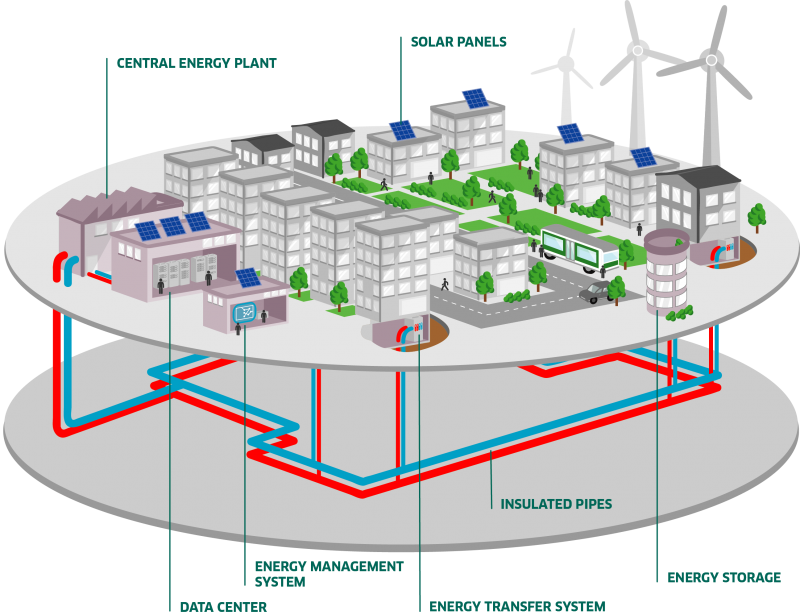District Heating - Yes, we can.

What is district heating?
District heating is the term used to describe a heating system that heats more than a single building or dwelling. If you’ve seen a video or movie filmed in New York City in the winter, the thick plumes of steam you see coming from manhole covers in the road are sometimes caused by the boilers of large buildings normally located in the basements which heat water and provide the heating for a building or multiple buildings (district).
Most common in cities, where the population density is higher and it doesn’t make sense for every person in an apartment block to have their own heating system installed, district heating supplies many dwellings from a single energy source and delivers the heat to all of the apartments individually. District heating has been around hundreds of years (in various manners) all over the world. Today, it lends itself particularly well to using ground source heat pumps as the prime energy mover.
Why does this make sense for GSHP’s
So why do GSHP’s lend themselves to district heating so well. There are a few answers but the simplest is scale. The largest element of cost in a GSHP system are the groundworks. Both excavating/drilling and pipe installation. The larger you make the groundwork, the lower the cost per unit of capacity.
The second answer is space. Whilst a single dwelling, especially in a city, may not have the land available to install the required loop, a whole street of houses or an apartment complex will have a much larger footprint and so it makes it much easier to conduct the installation of larger systems.
Third, GSHP’s don’t necessarily need to be tied directly to a “ground loop”, (though for space conditioning this is an excellent source of renewable energy). Where available they can also utilize a variety of sources and sinks of thermal energy. Think about the heat available in wastewater, lake water, ambient heat in subways or heat rejected from industrial process or refrigeration, etc. It’s all about moving heat from an area of higher concentration to an area of lower concentration, efficiently. The Ground/Water source heat pump is the technology that allows this transfer.
Examples of GSHP district heating
Ok, so there are a few advantages to scaling up the GSHP system, on paper at least, but how can we be sure it would work in practice? Because it already is, and in many parts of the world no less.
If you haven’t recently seen the developments in Toronto, ON. At the project called “The Well”, have a look here: https://www.cbc.ca/news/business/climate-heat-cooling-1.5437701. Enwave operates a lake water district cooling system and has for years serving many buildings in downtown Toronto. This project will add a giant “buffer tank” beneath the building to serve as a thermal buffer to reduce electricity usage during peak periods of the day.
Meanwhile, across the globe, underground industrial plants probably conjure up images of James Bond and evil lairs; in Helsinki, work is ongoing to expand a pre-existing GSHP district heating system located under the Katri Vala Park. See this link for a short video:
When finished this project will reach a staggering capacity of 90Mw. No, that isn’t a typo, 90 Megawatts.
The system, which already has 5 heat pumps, is having a larger 6th one installed. It is expected that when it comes online in 2021 this heat pump alone will increase capacity by a whopping 200,000 MWh per annum. This upgrade is expected to cost in the vicinity of around €20m and save around 65,000 tonnes of carbon dioxide per year. A significant saving which will help Finland, and the EU, reach their Paris Agreement goals.
Across the North Sea in London a development of over 500 flats on the banks of the river Thames uses an aquifer as a source of geothermal energy. This three heat pump system, installed in the early 2010s, provides a maximum of 1.8Mw of heating for the flats and also for some attached commercial spaces. The cost per Mw of this system is higher than in Finland, £2m in total, but in a city where there are few pubs where you can find a beer for less than CAD$9 the price tag may be a lot lower than it would first appear. Especially when you remember that you might just be able to afford a few more of those beers as you won't be paying for Natural gas, propane or oil to keep yourself warm at night.
Another example in the UK is the Wynford Estate in Glasgow. This scheme has a 1.2Mw system which provides heat to almost 2,000 homes and is expected to save 7,000 tonnes of carbon dioxide every year.
What could Canada learn from the rest of the world?
So we’ve established that large scale GSHP systems are not only possible but that they are also already being used to great effect in other parts of the world with similar heating requirements to us. But can we learn anything else from our friends innovations?
A report by the now-defunct Department of Energy & Climate Change (DECC), a part of the British government, commissioned a study called “Heat Pumps in District Heating” in 2016 which raised a few interesting points. In case you’ve just panicked wondering how you will read a 135-page document before bedtime, don’t worry, we’ve summarised some of the key points below.
- These systems are cheaper if the site has both cooling and heating needs
- There is no one size fits all solution, different heat pump systems should be considered for all sites
- Residents in buildings which use GSHP heating will require some education on how to use the system
- District heating can save 48-84% of CO2 emissions compared to fossil fuel heating sources.
One other thing we may want to consider is the legislation surrounding these systems. GSHP systems cost more to install but are much cheaper in the long run. However, when it comes to towering office blocks or trendy condo complexes the developer and the owner/occupier are likely to be different people. This means that the best way to encourage developers to install large scale GSHP’s into new developments is by introducing legislation/code to require it on new buildings. This seems to be happening, but we need to speed this process up. It’s up to the individual municipalities to take action and push this ahead.
MORE ARTICLES
HEPA Filtration What is the RHI and what can Canada learn Specifying Evaporative Cooling Equipment: A Quick Reference How Geothermal Works








